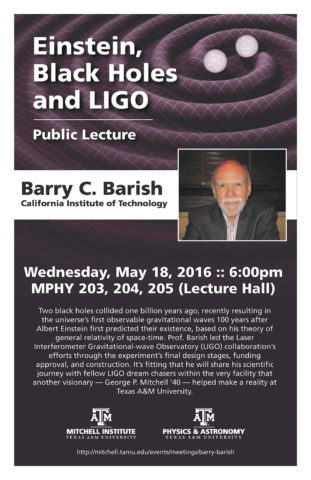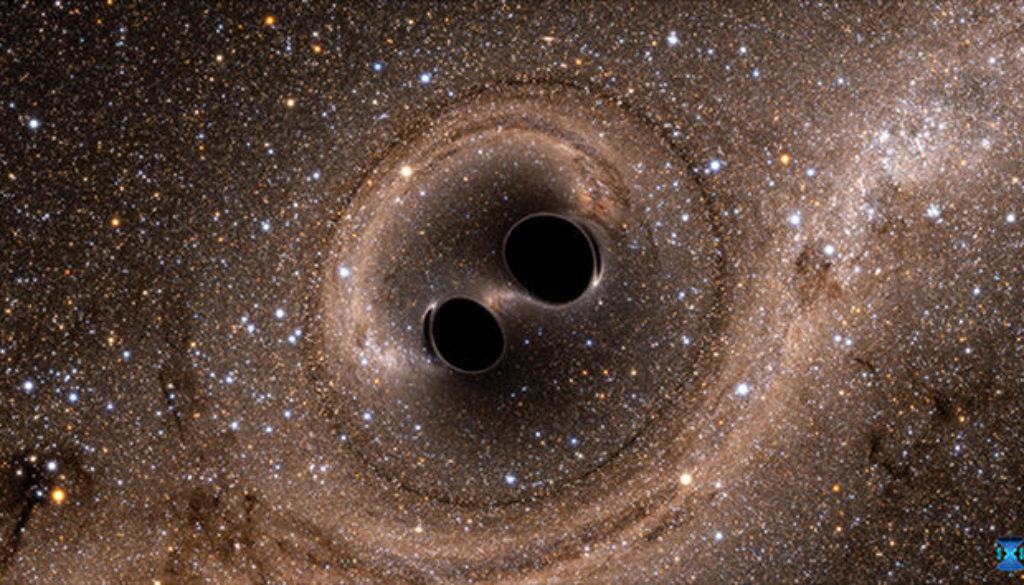Caltech Physicist to Present Public Lecture on LIGO Experiment
COLLEGE STATION —
California Institute of Technology physicist Barry C. Barish, former director of the Laser Interferometer Gravitational-wave Observatory (LIGO) and creator of the LIGO Scientific Collaboration (LSC) that includes more than 1,000 collaborators worldwide, will visit Texas A&M University next week to deliver a free public lecture detailing his role in the groundbreaking experiment recognized earlier this month with the prestigious $3 million Special Breakthrough Prize in Fundamental Physics.

Barish will present Einstein, Black Holes and LIGO on Wednesday (May 18) at 6 p.m. in the second-floor primary lecture hall of the George P. Mitchell ’40 Physics Building. Tickets are not required for the free event, which is sponsored by the George P. and Cynthia Woods Mitchell Institute for Fundamental Physics and Astronomy and the Department of Physics and Astronomy in conjunction with the May 17-20 U.S. CMS (Compact Muon Solenoid) Collaboration Meeting. Both the meeting and the lecture are hosted by the Texas A&M CMS group, which includes Texas A&M high-energy physicists Ricardo Eusebi, Teruki Kamon, Alexei Safonov and Keith Ulmer.
Two black holes collided one billion years ago, recently resulting in the universe’s first observable gravitational waves 100 years after Albert Einstein first predicted their existence, based on his theory of general relativity of space-time. As one of the initial principal investigators for LIGO, Barish led the collaboration’s efforts through the experiment’s final design stages, funding approval and construction. He continues to play a leadership role in LIGO, from the ongoing implementation of Advanced LIGO — the experiment’s current phase that features 10 times the sensitivity and more than 1,000 times the detection potential — to his service on the LSC executive committee.
Kamon, Mitchell Institute deputy director and event organizer, says it’s fitting that Barish will share his scientific journey with fellow LIGO dream chasers within the very facility that another visionary — George P. Mitchell ’40 — helped make a reality at Texas A&M University.
“Barry Barish’s lecture offers the opportunity, thanks in large part to Mr. Mitchell and the Mitchell family, to learn from one of the world’s top authorities on LIGO and many other pioneering international experiments that have revolutionized particle physics,” Kamon said.
Barish, a National Academy of Sciences member since 2002, earned both his bachelor of arts in physics (1957) and Ph.D. in experimental particle physics (1962) at the University of California, Berkeley. He came to Caltech as a postdoc in 1963, where he has pursued his academic and research careers. Barish was named the Maxine and Ronald Linde Professor of Physics at Caltech in 1991 and since 2005 is the Maxine and Ronald Linde Professor of Physics, Emeritus.

Beyond LIGO, Barish has performed other noteworthy experiments, including high-energy neutrino collisions at Fermilab that revealed the quark substructure of the nucleon. These experiments were among the first to observe the weak neutral current, a linchpin of the electroweak unification theories of Glashow, Salam and Weinberg. Following the neutrino experiment, Barish developed an ambitious international effort to open up a new field of particle astrophysics. The experiment, MACRO, located in the Gran Sasso Tunnel in Italy, produced the most sensitive search for the heavy magnetic monopoles that are predicted in Grand Unified Theories. MACRO also studied penetrating cosmic rays, including neutrino measurements that provided important confirmatory evidence that neutrinos have mass and oscillate. Barish also is the former director of the Global Design Effort for the International Linear Collider (ILC) .
Barish is an elected member of the American Academy of Arts and Sciences and is a fellow of both the American Association for the Advancement of Science (AAAS) and the American Physical Society (APS). He served as APS president in 2011 and on many important science committees, including co-chairing the High Energy Physics Advisory Panel subpanel that developed a long-range plan for U.S. high energy physics in 2001. He has also has chaired the Commission of Particles and Fields and the U.S. Liaison committee to the International Union of Pure and Applied Physics (IUPAP), in addition to being very active in international collaboration for physics. Barish was given a Presidential appointment and served on the National Science Board, the 24-member board that oversees the National Science Foundation (NSF) and advises the President and the Congress on policy issues related to science, engineering and education.
# # # # # # # # # #
About Research at Texas A&M University: As one of the world’s leading research institutions, Texas A&M is at the forefront in making significant contributions to scholarship and discovery, including that of science and technology. Research conducted at Texas A&M represented annual expenditures of more than $866.6 million in fiscal year 2015. Texas A&M ranked in the top 20 of the National Science Foundation’s Higher Education Research and Development survey (2014), based on expenditures of more than $854 million in fiscal year 2014. Texas A&M’s research creates new knowledge that provides basic, fundamental and applied contributions resulting in many cases in economic benefits to the state, nation and world. To learn more, visit http://research.tamu.edu.
-aTm-
Contact: Shana K. Hutchins, (979) 862-1237 or shutchins@science.tamu.edu or Dr. Teruki Kamon, (979) 845-7740 or kamon@physics.tamu.edu
The post Caltech Physicist to Present Public Lecture on LIGO Experiment appeared first on College of Science.
